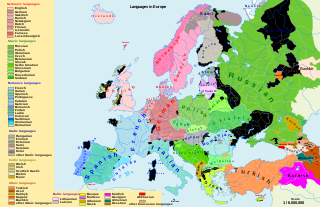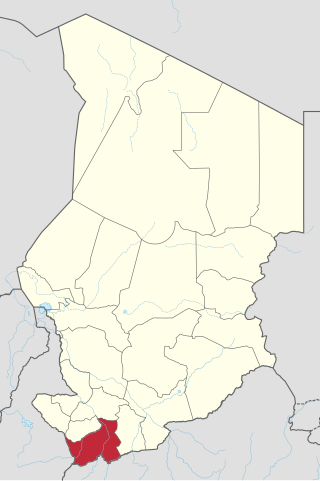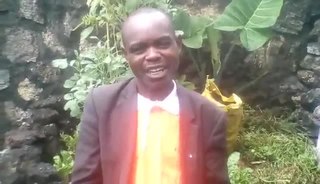Related Research Articles

There are over 250 languages indigenous to Europe, and most belong to the Indo-European language family. Out of a total European population of 744 million as of 2018, some 94% are native speakers of an Indo-European language. The three largest phyla of the Indo-European language family in Europe are Romance, Germanic, and Slavic; they have more than 200 million speakers each, and together account for close to 90% of Europeans.
The Fer language, also Dam Fer or Fertit, one of several languages called Kara, is a Central Sudanic language spoken by some five thousand people in the northern Central African Republic near the Sudanese and Chadian borders, in the region known as Dar Runga.
The Sara languages comprise over a dozen Bongo–Bagirmi languages spoken mainly in Chad; a few are also spoken in the north of the Central African Republic. They are members of the Central Sudanic language family. Greenberg (1966) treats all varieties as dialects of a Sara language, whereas Tucker and Bryan (1966) consider the Sara to be a dialect cluster of several languages. Most members of the different Sara languages/dialects consider their speech form distinct languages, but there is currently insufficient language information to determine which speech varieties need to be considered distinct languages, and which are dialects of other languages.

Mandoul is one of the 23 regions of Chad. Located in the south of the country, it comprises part of the former prefecture of Moyen-Chari. The regional capital is Koumra.

Logone Oriental is one of the 23 regions of Chad, located in the south-west of the country. Its capital is Doba. It is coterminous with the former Logone Oriental Prefecture.

Pashayi or Pashai is a group of Indo-Aryan languages spoken by the Pashai people in parts of Kapisa, Laghman, Nangarhar, Nuristan, Kunar and Kabul provinces in Northeastern Afghanistan.
The Bongo–Bagirmi or Sara–Bongo–Bagirmi (SBB) languages are the major branch of the Central Sudanic language family with about forty languages. Principal groups include Bagirmi languages such as Naba and the Sara languages. They are spoken across CAR, Chad, South Sudan, Sudan and adjacent countries.

Lega is a Bantu language, or dialect cluster, of the Democratic Republic of the Congo. There are two major varieties, Shabunda Lega and Mwenga Lega; Mwenga Lega, with about 10% of speakers, finds Shabunda difficult to understand. Kanu has been assigned a separate ISO code but is a dialect of Shabunda, and no more divergent than other dialects.
Falam Chin is a Kuki-Chin language in Falam Township, Chin State, Myanmar, and also in Mizoram, India.
Central Banda is a dialect continuum of the Banda languages spoken by around one million people, primarily in the Central African Republic. The varieties may be mutually intelligible, especially the Mid-Southern–Gobu–Kpagua–Mono–Ngundu cluster. The other varieties are Bambari, Banda-Banda, Mbrès, Ndélé, and Togbo-Vara Banda.
Kaba proper is a Bongo–Bagirmi language of Chad and the Central African Republic. It is one of several local languages that go by the names Kaba and Sara. There are three ISO codes, which Ethnologue acknowledges may be the same thing.
Kaba Démé, or just Dem, is a Bongo–Bagirmi language of Chad and the Central African Republic. It is one of several local languages that go by the names Kaba and Sara.
Kaba (Kabba), or Kabba of Goré, is a language of the Sara people in Central African Republic and Chad, with around 100,000 speakers.
Mbay, or Sara Mbay, is a Bongo–Bagirmi language of Chad and the Central African Republic.
Ngam, or Sara Ngam, is a Bongo–Bagirmi language of Chad and the Central African Republic.
Sar or Sara, also known as Madjingay and Sara Madjingay is a Bongo–Bagirmi language of southern Chad, and the lingua franca of regional capital of Sarh.
Kaba So, also known as Kulfa after its primary dialect, is a Bongo–Bagirmi language of Chad. It is nearly intelligible with Kaba Na, which is used as a second language.
Lamaholot, also known as Solor or Solorese, is a Central Malayo-Polynesian dialect cluster of Flores, Indonesia. The varieties may not be all mutually intelligible; Keraf (1978) reports that there are 18 languages under the name.
Laka, also known as Kabba Laka, is one of the Sara languages of Chad.
Gula is a Bongo–Bagirmi language of Chad.
References
- The Sara-Bagirmi Language Project -- Mango
- The Sara-Bagirmi Language Project -- Gor
- The Sara-Bagirmi Language Project -- Bebote
- ↑ Bedjond (Nangnda) at Ethnologue (18th ed., 2015) (subscription required)
Mango at Ethnologue (18th ed., 2015) (subscription required)
Gor at Ethnologue (18th ed., 2015) (subscription required)